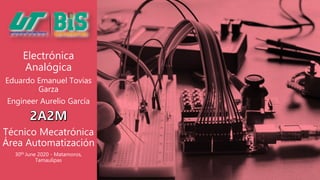
Diodes
- 1. Electrónica Analógica Eduardo Emanuel Tovias Garza Engineer Aurelio García Técnico Mecatrónica Área Automatización 30th June 2020 - Matamoros, Tamaulipas
- 3. In physics and electrical engineering, a conductor is an object or type of material that allows the flow of charge (electrical current) in one or more directions. Materials made of metal are common electrical conductors. Electrical current is generated by the flow of negatively charged electrons, positively charged holes, and positive or negative ions in some cases. Excellent Conductor of Electricity: Copper is an excellent conductor of electricity; no other metal can compete with it in terms of electrical conductivity. The wires made of this reddish metal are capable of carrying comparatively more electric current per diameter of wire. Copper is used for making electrical wires that are used, due to its properties that make it an ideal metal for this purpose.
- 4. An electrical insulator is a material in which the electron does not flow freely or the atom of the insulator have tightly bound electrons whose internal electric charges do not flow freely; very little electric current will flow through it under the influence of an electric field. This contrasts with other materials, semiconductors and conductors, which conduct electric current more easily. The property that distinguishes an insulator is its resistivity; insulators have higher resistivity than semiconductors or conductors. The most common examples are non-metals. Insulators are used to protect us from the dangerous effects of electricity flowing through conductors. Sometimes the voltage in an electrical circuit can be quite high and dangerous. If the voltage is high enough, electric current can be made to flow through even materials that are generally not considered to be good conductors Insulators have low conductivities, practically don’t allow the electric circuit to flow through them
- 5. Semiconductor, any of a class of crystalline solids intermediate in electrical conductivity between a conductor and an insulator. Semiconductors are employed in the manufacture of various kinds of electronic devices, including diodes, transistors, and integrated circuits. Semiconductors materials such as silicon (Si), germanium (Ge) and gallium arsenide (GaAs), have electrical properties somewhere in the middle, between those of a “conductor” and an “insulator”. They are not good conductors nor good insulators (hence their name “semi”-conductors). They have very few “free electrons” because their atoms are closely grouped together in a crystalline pattern called a “crystal lattice” but electrons are still able to flow, but only under special conditions. Allow a portion of electric current to flow through them Different types of diodes
- 7. Instrictic Extrictic when the network is not doped with any impurity, an intrinsic semiconductor is known, which is a pure semiconductor and behaves like an insulator, that means that the number of atoms and holes is complete When we dope our electron network we call it an N-type extrinsic semiconductor When we dope it with holes we call it an extrinsic semiconductor P-type
- 8. P-Type Extrinsic Material A semiconductor P, is a semiconductor that has increased a number of holes, which allows the holes to be used as links, this hole can be used to receive electrons and can promote the flow of electrons during an electric current. Note: P = Positive, allows the Flow of electrons with holes. N-type = Negative, allows the Flow of eletrons with extra electrons that with a voltage this allows the Flow of current.
- 9. N-Type Extrinsic Material Mainly when an impurity is added, this has been an N-type semiconductor, this means that by applying a voltage, the electrons are pushed from one side to the other, allowing the flow of electrons.
- 10. The PN junction is the border where the, so this structure is also called a junction diode. N and P regions meet. This separation of charges causes the appearance of an electric field that opposes the diffusion of carriers. This means that the field will eventually stop the diffusion of electrons through the junction. We can say that the electric field creates a potential barrier that prevents the diffusion of electrons.
- 11. A PN-junction diode is formed when a p-type semiconductor is fused to an n-type semiconductor creating a potential barrier voltage across the diode junction When a diode is connected in a Forward Bias condition, a negative voltage is applied to the N-type material and a positive voltage is applied to the P-type material. If this external voltage becomes greater than the value of the potential barrier, approx. 0.7 volts for silicon and 0.3 volts for germanium, the potential barriers opposition will be overcome and current will start to flow.
- 12. When a diode is connected in a Reverse Bias condition, a positive voltage is applied to the N-type material and a negative voltage is applied to the P-type material. The positive voltage applied to the N-type material attracts electrons towards the positive electrode and away from the junction, while the holes in the P-type end are also attracted away from the junction towards the negative electrode. The net result is that the depletion layer grows wider due to a lack of electrons and holes and presents a high impedance path, almost an insulator. The result is that a high potential barrier is created thus preventing current from flowing through the semiconductor material.
- 13. D i o d e Junction Diode Symbol and Static
- 14. Datasheet for diodes 1N400x The 1N400x (or 1N4001 or 1N4000) series is a family of popular 1 A general- purpose silicon rectifier diodes commonly used in AC adapters for common household appliances. Its blocking voltage varies from 50 volts (1N4001) to 1000 volts (1N4007). This JEDEC device number series is available in the DO- 41 axial package, and similar diodes are available in SMA and MELF surface mount packages (in other part number series). The 1N400x series was originally introduced by Motorola's Semiconductor Products Division and registered at JEDEC in 1963, as silicon power rectifiers primarily for military and industrial applications.